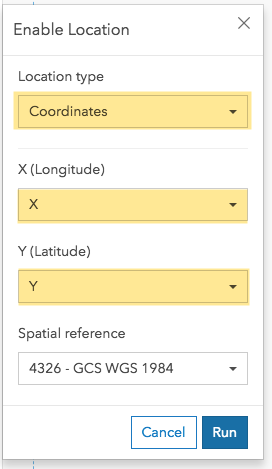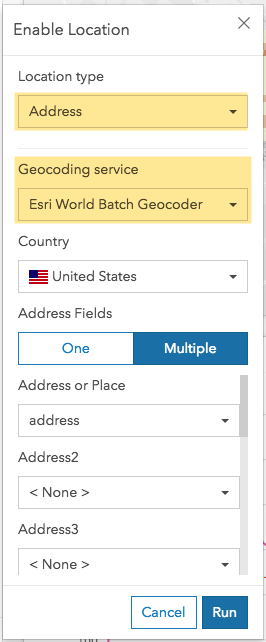- Home
- :
- All Communities
- :
- Products
- :
- ArcGIS Insights
- :
- ArcGIS Insights Questions
- :
- Re: Insights feature number limit for location dis...
- Subscribe to RSS Feed
- Mark Topic as New
- Mark Topic as Read
- Float this Topic for Current User
- Bookmark
- Subscribe
- Mute
- Printer Friendly Page
Insights feature number limit for location display?
- Mark as New
- Bookmark
- Subscribe
- Mute
- Subscribe to RSS Feed
- Permalink
I'm evaluating Insights 2.1 on Portal 10.5.1.
I am attempting to access spatial data from Lat, Long columns in a table drawn from a SQL Server table view. The source data has approximately 242,000 records (parcel centroids for a local county government). I can load the table without issue into Insights, but if I attempt to enable a location (using the Lat, Long coordinates) I get a message that says "Something went wrong". No more details.
This seems to be a problem with the SIZE of the table to process. I CAN enable location on an subset of the source data using a SQL "select top 10000" table view.
I just want to confirm that this IS a limitation with the number of location features? Is there a work around? I have also added a HOSTED feature service layer and this is able to display successfully, but I cannot link the Hosted feature services to SQL Server business tables.
Is there a better approach to getting large number of geospatially enabled features into Insights, and get them linked up with SQL Server business tables?
- Mark as New
- Bookmark
- Subscribe
- Mute
- Subscribe to RSS Feed
- Permalink
Does your SQL server location data have "X and Y" information? If so, can you please try that and let me know if that works for you? (X,Y does not use geocoding service - so trying to narrow the problem down)
- Mark as New
- Bookmark
- Subscribe
- Mute
- Subscribe to RSS Feed
- Permalink
The "lat" column is the "Y" column and the "long" column is the "X" column...
I'm passing in decimal degrees in EPSG 4326...
My source data is in Maryland State Plane Feet, but I've had to convert those "X,Y" values to decimal degrees prior to import to Insights, as projected coordinates (other than WMAS) don't seem to be supported yet.
I'm curious what "geocoding service" you refer to and when it is activated? Is this only for "address" type locations, as I'd expect?
Background:
I'm getting my feet wet with Insights to see what it can do... I'm just trying to display parcel centroid point data (for ~250k features) so that I can match this to SQL Server business tables for visualizing queries and analysis. For example, if you wanted to see all of the residential properties with active building permits for the last 6 months and chart the property value distribution for these selected properties. Once you have your geospatial and tabular data loaded and you create the "relationships" to other data tables, can you perform queries on the joined data? Is something like that possible with Insights? Or is that not a good use of this particular tool?
- Mark as New
- Bookmark
- Subscribe
- Mute
- Subscribe to RSS Feed
- Permalink
"I'm curious what "geocoding service" you refer to and when it is activated? Is this only for "address" type locations, as I'd expect?"
I was referring to what method are you using "Enabling Location" with Insights?

or using the Geocoding Service?

Insights for ArcGIS should allow you to perform the workflow you mentioned...
- Mark as New
- Bookmark
- Subscribe
- Mute
- Subscribe to RSS Feed
- Permalink
Yes, I'm using the "Coordinates" option in the "Location type" dropdown, with decimal degrees, latitude and longitude coordinates.
And I get the error I initially reported (but only for SQL tables/views with more than approx. 50k records).
Using the long,lat X,Y coordinates as location input does not work for me with this data set...
Do you have any suggestions for me to try?
- Mark as New
- Bookmark
- Subscribe
- Mute
- Subscribe to RSS Feed
- Permalink
Hello Andrew,
I apologize for noticing this very late. I was wondering if you could set ArcGIS Server logs to DEBUG and then run the Enable Location for it to return "Something went Wrong" and see if you can copy-paste the logs for the error?
Additionally,
Once you have your geospatial and tabular data loaded and you create the "relationships" to other data tables, can you perform queries on the joined data? Is something like that possible with Insights?
Yes, this is possible in Insights. As you mentioned before, the hosted feature layer you've published to Portal that contains a common field can then be joined with the SQL Server table view. The relationship you create between the feature layer and table should result in a new dataset in Insights that you can then add to the page to query.
Hope this makes sense. Please let me know if you'd like me to clarify or you have any other questions.
Thanks,
Aravind